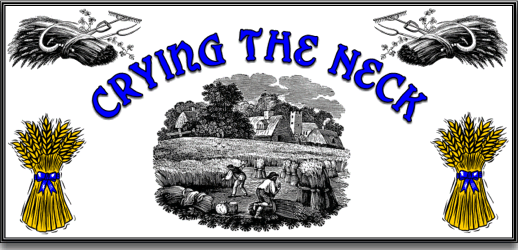
Due to the climate and altitude there was not a lot of corn grown on Dartmoor and what was cultivated tended to be on the lower fringes of the moor. But where either wheat or barley was sown the old tradition of ‘Crying the Neck’ was observed at harvest time. This custom was described in 1836 by W. Hone as:
“An old man, or someone well acquainted with the ceremonies used on the occasion (when the labourers are reaping the last field of wheat), goes round to the shocks and sheaves, and picks out a little bundle of all the best ears he can find; this bundle he ties up very neat and trim, and plats and arranges the straws tastefully. This is called “the neck” of wheat, or wheaten ears. After the field is cut out, and the pitcher (of cider) once more circulated, the reapers, binders, and the women stand round in a circle. The person with “the neck” stands in the centre grasping it with both hands. He first stoops and holds it near the ground and all the men forming the ring, take off their hats, stooping and holding them with both hands towards the ground. They then all begin at once in a very prolonged and harmonious tone to cry “the neck!” at the same time slowly raising themselves upright, and elevating their arms and hats above their heads; the person with “the neck” also raising it on high. This is done three times. Then they change their cry to “wee yen! wee yen!” which they sound in the same prolonged manner as before, with singular harmony and effect, three times. This last cry is accompanied by the same movements of the body and arms as in crying “the neck.”
After having thus repeated “the neck” three times, and “wee yen” or “way yen” as often, they all burst out into a kind of loud and joyous laugh, flinging their hats and caps into the air, capering about and perhaps kissing the girls. One of them gets the “neck” and runs as hard as he can to the farm-house, where the dairy-maid, or one of the young female domestics, stands at the door prepared with a pail of water. If he who holds “the neck” can manage to get into the house, in any way unseen, or openly, by any other way than the door at which the girl stands with the pail of water, then he may lawfully kiss her; but if otherwise, he is regularly soused with the contents of the bucket. On a fine still autumn evening, the “crying of the neck” has a wonderful effect at a distance.”
Sabine Baring Gould describes how Mrs Bray came across the finale of a ‘Crying the Neck’ ceremony: “We were passing near a field on the fringe of Dartmoor, where the reapers were assembled. In a moment the pony started nearly from one side of the way to the other, so sudden came a shout from the field which gave him this alarm. On my stopping to ask my servant what all this noise was about, he seemed surprised by the question, and said, ‘It was only the people making their games, as they always did, to the spirit of the harvest.”
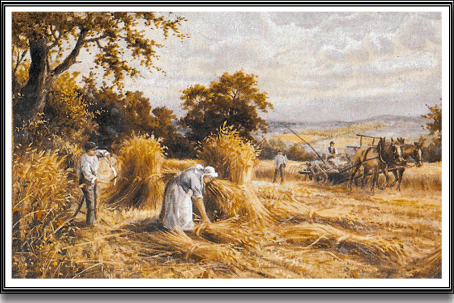
At one time the custom of “Crying the Neck” was common throughout the whole of Devon. The tradition varied slightly with regard to the smaller details throughout the parishes but the main points were basically identical. The “neck” actually resembled a female doll with a narrow waist and spreading waist. After the ceremony it was normally hung up in the farm kitchen and stayed there until the following year’s harvest was gathered, then it would be burnt and replaced with the new one. In some cases the “neck” was kept until after Christmas, then when the fields were ploughed, normally on ‘Plough Monday’ (the first Monday after Twelfth Night) it was taken out and ploughed into the first furrow. There was also a custom where the “neck” would be kept on the kitchen table for a year and then fed to the best ‘beast in the stall‘.
During the harvest there would be a great deal of rivalry between the farms as to which harvest gang could be the first to finish. As soon as the last field was done the workers would go to the highest point on the farm and shout the following verse:
We-ha-neck! we-ha-neck!
Well aplowed! Well asowed!
We’ve reaped! And we’ve a-mowed
Hurrah! Hurrah! Hurrah!
Well-a-cut – well abound!
Well-a-zot upon the ground!
We-ha-neck! We-ha-neck!
Hurrah! Hurrah! Hurrah!
In some cases a gun was fired for greater effect and to perhaps add an air of finality to the proceedings. Cider would also be passed around as a toast to a successful harvest. After the ceremonies were concluded the only, and probably the most popular event left, was the harvest home celebrations. This would be where the workers would assemble back at the farm and partake in a sumptuous meal washed down with copious amounts of cider or ale. In some areas the “neck” would be placed at the head of the table as a mark of respect.
But from where did the custom of ‘Crying the Neck’ originate? It is thought that it dates back to pagan times when some sacrifice was made on completion of the harvest. The “neck” could well represent the ‘spirit of the corn’ and as the harvest progresses from field to field the ‘spirit’ moves with it until the last field is the only refuge left. Once this has been cut the ‘spirit’ can be caught and metaphorically ‘killed’ thus ensuring a new youthful spirit the following year which would ensure a good harvest. It has been suggested that the word ‘neck’ comes from the Norse word which means a ‘sheaf of corn’. The last recorded ‘Crying of the Neck’ ceremony was probably in 1930. It is interesting to note that on the 22p stamp of the special ‘Folklore’ Royal Mail issue of 1981 that there is what appears to be a man holding a ‘neck’, see below.
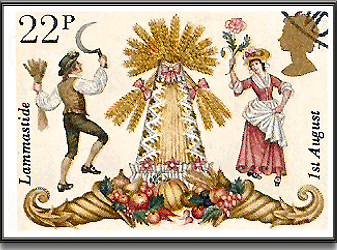
Imagine being sat on a hillside some hundred and fifty years ago. The air is filled with the smell of freshly cut straw and the sun is starting to set over the distant horizon. From your vantage point you can see small throngs of people gathered on various hills. The air is full of cries and shouts and perhaps the odd gun shot. Every field is filled with neat rows of corn shocks glimmering in the fading orange sunlight. Children are excitedly dancing and skipping through the corn stubble throwing the odd handful of straw at each other. All around there is an atmosphere of relief, celebration and excitement because hopefully a fruitful harvest has been gathered which will mean food, coin and bedding throughout the fast approaching barren winter. It is as if this is the final act and now everybody is about to go into a state of hibernation from the icy winds and snow.
Harvest Morn.
The Stars are gone, the night is done,
The lark as hailed the day;
And labouring men cheerily again
Hie to the field away.
The morning breeze, that waves the trees,
The mist sweeps from the stream,
While murmuring rills and towering hills Are tipt with days first beam.
Hurrah, Hurrah for the harvest morn
The merriest of the year;
Hurrah, hurrah, hurrah hurrah,
For all things gay appear.
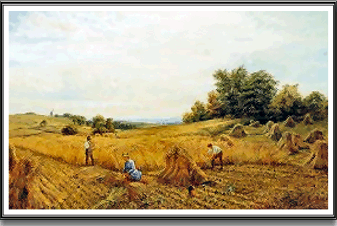
While yet the dew, – the diamond dew, –
Bespangles ripened corn,
The labour true how many woo
The bracing breath of morn.
No rural sound so sweet is found
As clank of sharpening scythe
And mountains greet, – with gladness greet, –
The songs of reapers blithe.
Hurrah, Hurrah for the harvest morn
The merriest of the year;
Hurrah, hurrah, for the hardy hands,
Who bind, mow, and shear.
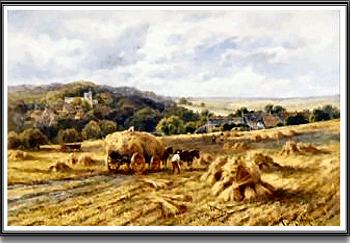
How many throng, with rake and prong,
The mower’s devious way,
And others lead the sower’s meed
To stack and barn away.
The summer sun, whose course is run,
Has shed his genial ray;
And golden grain, in vale and plain,
Await the harvest day.
Hurrah, Hurrah for the harvest morn
The best of all the year;
Hurrah, hurrah, hurrah hurrah,
For harvest home is near.
Musings in Moorland & Marsh – 1895.
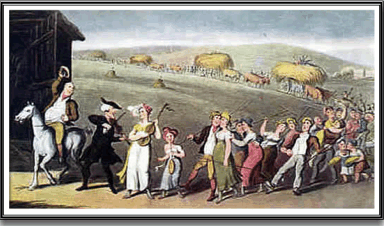
 Legendary Dartmoor The many aspects past and present of Dartmoor
Legendary Dartmoor The many aspects past and present of Dartmoor

How cool.
Also Poldark, series 2, episode 3.
I found this article searching Google for harvest song Poldark.
Nice article… The history is fabulous